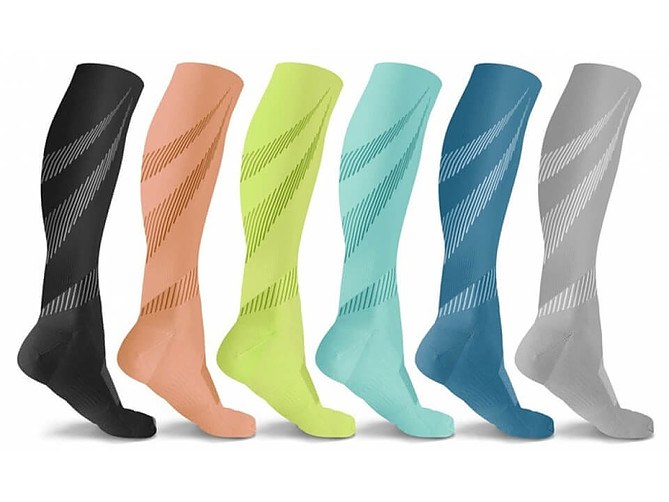In this article, you will learn more about compression socks, whether it will help diabetics, how different it is from regular socks. We will also get to review ComproGear compression socks to address the question Can ComproGear Compression Socks Help Diabetics. So, you can decide whether to buy it or not.
Read on…
Have you ever seen athletes wearing long socks or tubes on their legs and wondered why?
These socks are not worn solely for fashion or aesthetics, and they are unlike regular socks. Athletes wear it for a reason, that’s because they have hidden “superpowers” which is to apply gradual pressure on the legs.
These socks are called compression socks.
For people who have specific leg injuries, edema, etc. these socks are helpful.
What are Compression Socks?
Compression socks are uniquely designed socks that help to return venous blood to the heart more efficiently. They do so by applying gentle and graduated pressure on the legs. This pressure reduces swelling, pain, and other leg complications.
These socks are made with nylon and a somewhat stretchy material (spandex). Though the fabric used can differ slightly across brands. Recent designs also exploit innovative fabrics and sewing methods or technology to make comfortable socks, can apply graduated compression pressure and are easily washable, etc.
History of Compression Socks
The design of compression socks are modern, but the idea behind it is not. History has it that Roman soldiers tie bandages around their legs before or while embarking on long marches. This is to improve blood flow, hence their muscles won’t be as sore or ache much after the marches.
Compression socks can be prescribed by a doctor, gotten over the counter, or online. They are also available in different sizes, colors, prices, and strengths. Choose one that not only suits your taste but fits you comfortably, and you can easily afford.
Tip: Heard about Nano Socks which are popular among patients with diabetic neuropathy?
What is the Science Behind Circulation Problems?
Compression therapy is a type of treatment method that utilizes compression socks, bandages, etc as a tool to increase blood flow in the leg and to the heart.
These compression socks are used by people with circulation problems, athletes, etc.
Before I get into how compression socks work. The first question should be, why do people with circulation problems and athletes need compression socks? What is the science behind their condition?
The answer is venous insufficiency.
Back to our high school biology, we understand that an artery carries or supplies blood-rich in oxygen and nutrients-from our heart to other parts of our body. While a vein drains stale blood – rich in carbohydrates and toxins – back to the heart and lungs, often against gravity.
Both the artery and veins have doors (valves) that prevent blood from flowing backwards. They prevent blood from flowing backwards.
In venous insufficiency, your veins have a problem returning stale blood to your heart. This causes blood to pool to your leg, causing swelling, pain. Venous insufficiency may be caused by:
- Weakened valves
When the valves (in the veins) that control blood flowing in one direction pull apart, this is due to the collapse of the vein.
- Weakened muscle
Weakened calf and feet muscles can’t help pump venous blood back to the heart against gravity.
- Blood clots
These clots often obstruct the flow of venous blood. This can also cause blood to pool in the lower leg.
How Do Compression Socks work?
The gradual pressure these socks apply to your leg can be likened to the gentle and timed squeezing of your leg. This pressure supports the vein and also straightens it out. This means that the valves of the vein work as it should by allowing blood to flow in only a forward direction.
Types of Compression Socks
Compression socks are made to suit different conditions and purposes, so there are many types. We will look at the three major ones, which are:
- Anti-embolism compression socks
By embolism, we mean the total or partial blockage of blood flow by blood clots. These blood clots travel from where they are formed, through the bloodstream to another place entirely. The major cause of embolism is deep vein thrombosis, which is blood clots formed on major veins of extremities like the leg.
Anti-embolism compression socks (TED hose) made specifically for this condition provide lesser graduated pressure usually between 8-18mmHg.
They are worn by bedridden patients, to ensure effective blood circulation throughout their body. TED hoses are used by immobile people.
- Graduated compression socks
This type of compression socks is not like normal or non-medical compression socks that provide equal graduated pressure across your leg.
The graduated pressure levels across your leg differ. It is the strongest on your ankle and then decreases in pressure upward towards your knee.
The pressure they exert is typically higher, say, between 15-20mmHg or more. For a proper fit and to avoid injury, you need a prescription from a doctor.
- Non-medical compression socks
These are normal compression socks with lesser graduated pressure. They provide equal pressure across your leg. These socks can be gotten online or in the pharmacy.
They provide short term relief. If you suffer from non-serious conditions like achy or tired, then this is best for you. They are not effective for serious conditions.
Benefits of Compression Socks
From previous explanations, you may have gleaned some of the benefits of compression socks. However, for emphasis, here are some of those benefits and more.
- It serves as a support to the vein
- Used to treat diabetic ulcers
- It reduces leg edema or swelling
- To relieve achy or tired feet. It does so by reducing the lactic acid build-up usually cause by being in one position for a long time.
- Improves blood circulation in the extremities, e.g. leg
- It’s used to treat or manage deep vein thrombosis and varicose vein.
- Compression socks help people suffering from orthostatic hypotension.
Difference Between Compression Socks and Regular Socks
You may be wondering, can’t I substitute a really tight regular sock for compression socks? Won’t the tightness provide the needed pressure or compression on my leg?
The answer is No! It is dangerous, don’t try it. Especially if you are not just using it for your tired or achy feet and this is not even advisable. It can exacerbate the disease condition you are trying to treat. It does so by causing or reopening sores, restricted circulation, and so many other things.
The difference between compression socks and regular socks lies in the following areas:
- Fittings
For regular socks, you can either try out different socks until you find your fit or you can check your shoe size. For most compression socks, they require precise measurement for proper fittings. This is done by a medical doctor (e.g. Podiatrist) or professional.
Too tight or loose compression socks can either complicate your condition or not be effective at all.
- Prescription
You can buy regular socks anywhere clothes are sold or online. In contrast, compression socks can be gotten at the hospital, pharmacies, online, etc.
- Design
Regular socks come in different colors and designs. They are also made from different clothing materials. The major purpose, while producing them asides from comfort, is to make a fashion statement. They also have different lengths from ankle-high to knee-high etc.
For compression socks, they are made from different blends of clothing material. Though, some brands have different designs to satisfy your fashion sense. However, the purpose is not to make a fashion statement but to support or improve your health condition. They also come in different sizes and can even have one that is thigh or waist-high.
- Pressure
Regular socks only offer protection against dust, blisters, or comfort during cold weather. They are ineffective against serious conditions like deep vein thrombosis or diabetic ulcers. This is because they don’t have any active compression or pressure.
Now, as promised, let’s review the popular compression socks company called ComproGear.
What is ComproGear Compression Socks?
ComproGear is a brand that produces different sizes and colors of compression socks that can be worn by both men and women. As of now, they only have knee-length compression socks in their product line.
Features
When you buy compression socks from ComproGear, these are what you will see:
- Seamless stockings
- Wide range of color like black, red, nude, pattern, etc
- Different size range
- 20-30 mmHg compression
- Thick material
- Moisture-wicking fabric
- No-slip cuff
Pros
- Unisex
- It is made of thick fabric that does not roll or slide down
- The fabric absorbs moisture and keeps the skin dry
- Since it is seamless, it does not cause wounds or red marks on the leg.
This is helpful for diabetics since they are extra careful to avoid wounds and scrapes, so it does not lead to diabetic foot ulcers.
- Great refund policy
- Fast shipping
Cons
● Most people complain of size discrepancies. So, make sure to choose the proper size. You can refer to the size charts on their website.
Tip: You shouldn’t ignore MediPeds Compression Socks either.
Can ComproGear Compression Socks Help Diabetics?
Diabetics deal with a lot of complications that arise as a result of their condition. Complications such as diabetic neuropathy, diabetic foot ulcers, foot swelling, or edema. These complications can lead to total or partial leg amputation.
As a diabetic having a good foot care regime is important. That is because most times, especially in conditions like diabetic neuropathy, you may not be aware of any injury to your feet.
This foot care regime involves checking your feet every day for scrapes, sores, discoloration, etc. Part of this foot care regime also involves wearing compression socks that may be recommended by your doctor.
So yes, ComproGear compression socks or hosieries can help manage or prevent these complications. ComproGear compression socks and hosieries are non-invasive, unlike other treatment plans.
How Does It Help Diabetics?
Here are three reasons:
- Wearing ComproGear compression socks protects your leg from injuries, scrapes, etc.
These injuries may escalate to serious complications like foot ulcers and subsequently to leg amputation. It is also seamless and does not leave red marks on your leg.
- It reduces leg swelling or edema
Diabetics often suffer from swollen legs which is a circulation problem. It’s frustrating dragging a swollen leg around. It limits activity or movement.
ComproGear compression socks reduce edema to a manageable degree. It does so by applying gentle, and uniform graduated compression on your foot or lower legs.
- Help prevents Deep vein thrombosis (DVT)
DVT is when blood clot forms as a result of blood collecting in the lower legs. The blood clot may travel to other parts of the body like the lungs to cause harm (even death). Diabetics are more susceptible to DVT, that’s why wearing compression socks can prevent the risk of developing this condition.
Tips on Choosing the Right Compression Socks as a Diabetic
As a diabetic, you should be extra careful about the type of compression socks that you buy or are given. The wrong compression socks can further complicate your condition.
Here are some tips to keep in mind when choosing compression socks.
- Avoid compression socks that are too tight
While you need compression socks to improve blood circulation, you don’t need too tight ones that restrict blood flow to your legs.
Avoid compression socks with elastic bands at the top, they can cause injuries. Products like ComproGear compression socks are a good example of ones without elastic bands.
2. Choose compression socks made with soft materials
If you have any injury, don’t wear compression socks made with scratchy material. This can irritate and generally make you uncomfortable.
3. Choose seamless compression socks
This can’t be mentioned enough.
4. Depending on the diabetic complications, choose socks with or without toes
Some injuries especially on the foot require constant attention, compression socks without toes, can make it easier to check on them.
5. Choose compression socks with the right fit
Compression socks like ComproGear compression socks have size charts, which makes selection simpler.
Tips on How to Wear Compression Socks
Follow these tips.
- Don’t allow the socks to bunch up. Straighten the socks as you wear it
- Start wearing the socks from bottom to up
- Remove compression socks before taking your bath
- You can wear footwear over compression socks. Wear comfortable ones.
When Should I Not Wear ComproGear Compression Socks?
Compression socks are usually advised to be worn almost at all time except on certain occasions like before sleeping and in disease conditions like:
- Cellulitis
This is the inflammation of the skin, making it so hot and tender. Consequently, the tissue fluid can escape to the surrounding environment leading to edema (swelling of tissues).
- Ischemia
Due to the insufficient blood circulation in the leg or feet, it can lead to the greenish coloring of the tissue therein as the tissue oxygenation is greatly reduced.
- Peripheral arterial disease
Diabetics with disease affecting the diameter of the arteries of the leg and feet should avoid the use of compression stocks as the resulting consequences is fatal.
- Peripheral neuropathy
Diabetics type 2 patients almost always have a clinical presentation of periphery neuropathy. Such patients are advised to stay off from compression stocks.
- Congestive heart failure
This means the insufficiency of the heart to completely supply blood to the whole body system. Using compression stocks, in this case, is disastrous.
- Allergies
Don’t wear compression socks if you notice any new skin irritations or rashes. Skip wearing them. The skin irritation may be due to certain materials used in making the compression stocks etc.
Can I Sleep with ComproGear Compression Socks?
It’s usually not advised to wear compression stocks during sleep due to obvious reasons.
When you wear compression socks while sleeping, this can impede the blood flow towards the heart leading to cramps, necrosis, ischemia, and other blood vessels constricting related diseases.
The heart which is a muscular organ that pumps blood throughout the body is assisted by the force of gravity when standing, but on sleeping, such forces are obliterated leading to increased pressure in blood flow to circulate blood in the leg and feet. Using compression stocks during sleeping increases the pressure needed to supply blood to those parts, consequently leading to the insufficient blood supply to the aforementioned areas.
You can only wear compression socks to sleep only when it is prescribed by your doctor.
How to Take Care of ComproGear Compression Socks
Just as we care for our items of clothing, it’s very highly hygienic to wash and dry our compression stocks after each use. It is also advised to have more than one pair of compression socks for ease of use and care.
Tips on Wearing ComproGear Compression Socks
Here are tips to keep in mind while washing compression socks:
- While washing or rinsing, never twist or wring the compression socks as you do with regular socks.
This will cause the compression to lose its elasticity or compression.
Instead, gently squeeze the socks, then hang them to air dry.
- Never use a heater to dry your compression socks. Like I mentioned earlier, leave it to air dry.
- Never soak in hot water. Instead, soak the compression socks in cool, mild, or room temperature water.
Conclusion
Compression is a non-invasive alternative that can be utilized in managing diabetes and its complications.
Different types of compression are specific to certain conditions, and also there are different brands in the market. The key is to choose one that is best suited to you.
For diabetes without complications or that is not serious, wearing compression socks with little or moderate compression may suffice. For diabetes with complications, please seek the advice of your doctor.
I hope you got value out of this ComproGear Compression Socks Review. Share your experience with the ComproGear Compression Socks by commenting below.
Tip: Here are the Best Diabetic Socks made in the USA.









